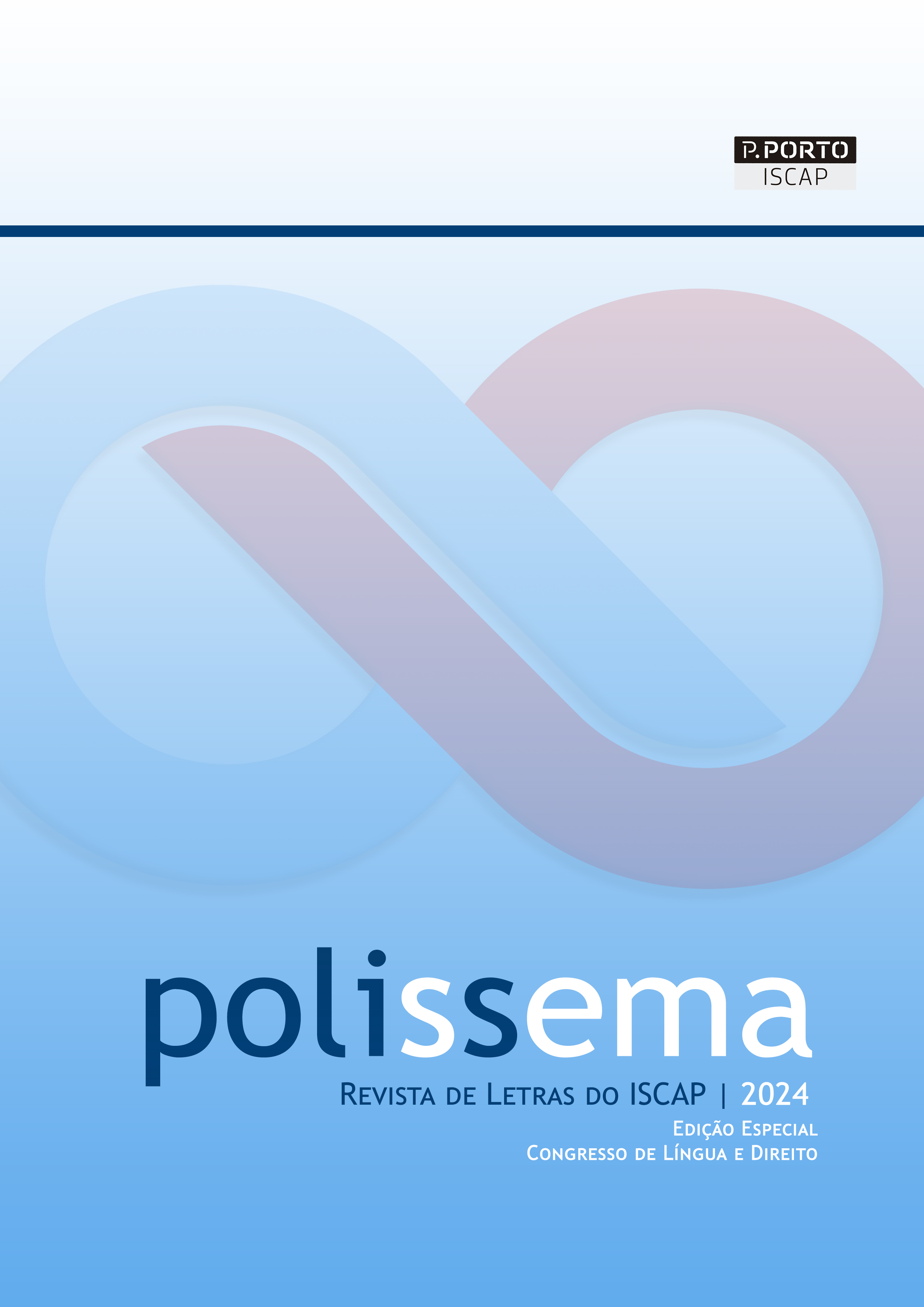THE LEGAL TRANSLATION LEXICAL SHEET AS A TEACHING EXPERIENCE IN LEGAL TRANSLATOR TRAINING
DOI:
https://doi.org/10.34630/polissema.vi.5607Keywords:
legal translation, translator training, legal translation studies, collaborative learningAbstract
Collaborative learning is considered one of the most suitable approaches for learner-centred strategies and is especially useful in today's translator training, due to its adequacy for the acquisition of translation skills. The implementation of collaborative strategies in translator training has led to a significant reduction in individual activities in the classroom, with an increasing weight of collective work, which facilitates the integration of the new translator into multidisciplinary teams. Legal translator training, found at the confluence of two legal systems, requires, in addition to the other transversal and specific skills required of a specialised translator, knowledge of the law and legal language, which places an additional burden on the design of the activities to be developed by the trainees.
This paper describes the implementation of a legal translation project as a teaching tool in legal translator training, as part of the Master's Degree in Specialised Translation and Interpreting at Instituto Superior de Contabilidade e Administração do Porto (ISCAP - P.PORTO). Its advantages as part of a collaborative approach to learning are also emphasised, as is the perception of the students, who validate the experience as a as a beneficial part of their learning, particularly when part of a comprehensive training strategy, based on the student's own construction of knowledge and the acquisition of specific and transversal competences, in accordance with the Competence Framework of the European Masters in Translation (EMT, 2022).
References
Bocquet, C. (2008). La traduction juridique. Fondement et méthode. De Boeck.
Cao, D. (2014). Teaching and learning legal translation. Semiotica (201), pp.103-119.
Cornu, G. (1990). Linguistique juridique. Montchrétien.
Cruz, R. & Magalhães, H. (2023). Ficha Juritradutológica: Témoin assisté (trabalho não publicado). ISCAP.
Davies, M. G. (2004). Multiple voices in the translation classroom: Activities, tasks and projects. John Benjamins.
EMT (2022). European Master’s in Translation Competence Framework. https://commission.europa.eu/news/updated-version-emt-competence-framework-now-available-2022-10-21_en.
Galán-Mañas, A. & Hurtado, A. (2015). Competence assessment procedures in translator training. In Mason, I. (ed.) The Interpreter and Translator Trainer. vol. 9 (1), pp. 63-82.
Gémar, J. C. (1982). Langage du droit et traduction, essais de jurilinguistique. Linguatech.
Gutiérrez-Artacho, J. & Olvera Lobo, M. D. (2016). Gamification in the translation and interpreting degree: A new methodological perspective in the classroom. Proceedings of EDULEARN 16. 8th Annual International Conference on Education and New Learning Technologies, pp. 50-58. https://digibug.ugr.es/handle/10481/43643.
Huertas Barros, E. (2011). Collaborative learning in the translation classroom: preliminary survey results. The Journal of Specialised Translation, 16, pp. 42-60. https://jostrans.org/issue16/art_barros.pdf
Johnson, D. W. & Johnson, R. T. (1989). Cooperation and Competition: Theory and Research. Interaction Book Company.
Johnson, D. W. & Johnson, R. T. (1994). Cooperative Learning in the Classroom. University of Michigan.
Kelly, D. A. (2002). Un modelo de competencia traductora: bases para el diseño curricular. Puentes. Hacia nuevas investigaciones en la mediación intercultural 1, pp. 9-20. http://wpd.ugr.es/~greti/revista-puentes/pub1/02-Kelly.pdf.
Kiraly, D. (2001). Towards a constructivist approach to translator education, Quaderns. Revista de traducció 6. https://www.raco.cat/index.php/QuadernsTraduccio/article/download/25282/25116/0.
Lasnier, F. (2000). Réussir la formation par compétences. Guérin.
Marczak, M. (2018=. Translation Pedagogy in the Digital Age. Angles, 7, pp. 1-19. http://journals.openedition.org/angles/895.
Montjean-Decaudin, S. (2022). Traité de juritraductologie; Épistémologie et méthodologie de la traduction juridique. Septentrion.
Monjeau-Decaudin, S. e Popineau-Lauvray, J. (2019). How to apply comparative law to legal translation - A new juritraductological approach to the translation of legal texts. In: Biel, Ł., Engberg, J., Ruano, R. M., e Sosoni, V. (eds.). Research methods in legal translation and interpreting: crossing methodological boundaries. Routledge, pp. 115-129.
Nord, C. (2005). Text analysis in translation: Theory, methodology, and didactic application of a model for translation-oriented text analysis. Rodopi (second edition).
Prieto Ramos, F. (2014). Parameters for problem-solving in legal translation: Implications for legal lexicography and institutional terminology management. In L. Cheng, K. Kui Sin & A. Wagner (eds.) The Ashgate Handbook of Legal Translation, pp. 121–134. Ashgate.
Pym, A. (2012). Training Translators. In K. Malmkjær & K. Windle (eds.) The Oxford Handbook of Translation Studies (e-book), pp. 313-322. Oxford University Press.
Šarčević, S. (2015). Language and Culture in EU Law: Multidisciplinary Perspectives. Routledge.
Shamma, T. (2015). Competition and Collaboration in Translation Education: The Motivational Impact of Translation Contests. In Y. Cui & W. Zhao (eds.) Handbook of Research on Teaching Methods in Language Translation and Interpretation, pp. 1-26. IGI Global.
Schmitt, P. A. (2019). Translation 4.0 – Evolution, Revolution, Innovation or Disruption? Lebende Sprachen. 64(2), pp. 193–229. https://www.researchgate.net/publication/337278785_Translation_40_-_Evolution_Revolution_Innovation_or_Disruption
Smith, B. L. & MacGregor, J. T. (1992). What is collaborative learning? In: A. S. Goodsell, M. R. Maher & V, Tinto (eds.) Collaborative Learning: A Sourcebook for Higher Education, pp. 10-30. NCTLA.
Sousa, B. & Freitas, W. (2023). Ficha Juritradutológica: Juiz Desembargador (trabalho não publicado). ISCAP.
Statista (2022). Market size of the global language services industry from 2009 to 2019 with a projection until 2022. https://www.statista.com/statistics/257656/size-of-the-global-language-services-market/.
Tallone, L. (2022). Institutional Translation and Interpreting. Assessing Practices and Managing for Quality, by Fernando Prieto Ramos (ed.). Polissema–Revista de Letras do ISCAP, 1(22), pp. 265-270.
Way, C. (2012). A discourse analysis approach to legal translator training: More than words. International Journal of Law, Language and Discourse, 2(4), pp. 39-61.
Way, C. (2016). The challenges and opportunities of legal translation and translator training in the 21st century. International Journal of Communication (10), pp. 1009–1029.
Downloads
Published
How to Cite
Issue
Section
License
Copyright (c) 2024 POLISSEMA – ISCAP Journal of Letters

This work is licensed under a Creative Commons Attribution-NonCommercial-NoDerivatives 4.0 International License.


